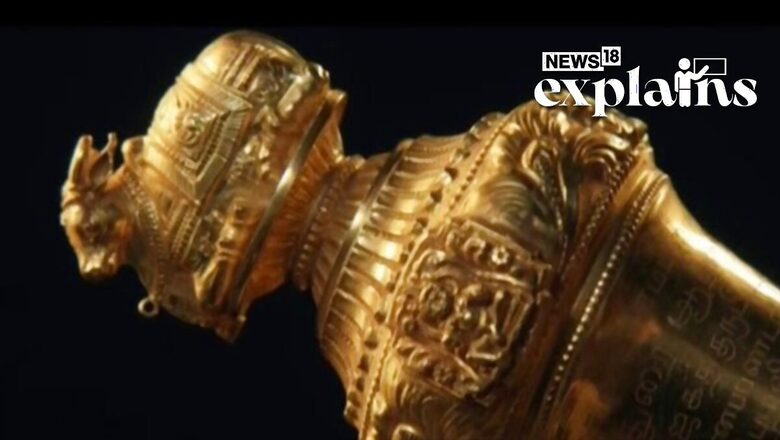
views
Union Home Minister Amit Shah announced that a historical Sengol, symbolizing the transfer of power from the British, will be prominently installed at the upcoming Parliament Building. Read more on this
“This Sengol has a huge significance. At around 10.45 PM on August 14, 1947, late Prime Minister Pandit Jawaharlal Nehru received this Sengol from Tamil Nadu, and in the presence of several senior leaders, he accepted this as a symbol of achieving independence. It is a sign of a shift of power from Britishers to The people of this country,” Shah said.
Union Home Minister Amit Shah highlighted the significant role of Sengol in Indian culture, particularly Tamil culture, during his announcement. He emphasized its historical importance, tracing back to the Chola dynasty. The Minister revealed that the esteemed Sengol would find its place within the New Parliament Building, symbolizing a transfer of power. Prime Minister Narendra Modi would receive the Sengol from Tamil Nadu before the official inauguration of the Parliament Building, where it would be prominently placed near the seat of the speaker.
Let’s understand what a Sengol is and what is its history:
The Chola Tradition
During the Chola period, the Sengol held immense significance in the coronation ceremonies of kings. It served as a ceremonial spear or flagstaff that featured elaborate carvings and intricate decorative elements. The Sengol was considered a sacred emblem of authority, representing the transfer of power from one ruler to the next.
The Chola dynasty was renowned for its extraordinary contributions to architecture, arts, and the patronage of literature and culture. The Sengol emerged as an iconic symbol of the Chola reign, symbolizing the power, legitimacy, and sovereignty of the Chola kings.
In contemporary times, the Sengol continues to be highly esteemed and holds deep cultural importance. It is venerated as a symbol of heritage and tradition, serving as an integral part of various cultural events, festivals, and significant ceremonies. The presence of the Sengol serves to honor and pay tribute to the rich history and legacy of Tamil culture.
Sengol’s History With Independent India
During the discussions regarding the symbolic ceremony for the transfer of power from British to Indian hands, Viceroy Lord Mountbatten posed a question to Pandit Jawaharlal Nehru, the first Prime Minister of independent India. Mountbatten inquired about the appropriate ceremony to signify this significant event.
In response, Nehru sought the advice of the respected statesman, C. Rajagopalachari, commonly known as Rajaji. Rajaji suggested drawing inspiration from the Chola dynasty’s model of power transfer, where the transition from one king to another was sanctified and blessed by high priests.
Union Home Minister Amit Shah announces that Prime Minister Shri Narendra Modi will instal the sacred Sengol, gifted by a group of Priests on the eve of India's independence, in 1947, marking the transfer of power, in the New Parliament on 28th May 2023.The sacred Sengol… pic.twitter.com/jLjQqZiWAB
— Amit Malviya (@amitmalviya) May 24, 2023
According to Rajaji, the Chola model involved the symbolic handover of the “Sengol” from one king to his successor. The Sengol represented a symbol of authority and power. Its presentation to the new ruler was accompanied by the order, known as “aanai” in Tamil, which signified the responsibility to govern with “dharma,” meaning justly and fairly.
By adopting the Chola model and incorporating the ceremonial handover of the Sengol, the transfer of power from the British to Indian hands was symbolically represented. This decision reflected the reverence for ancient traditions and the cultural heritage of India while signifying the transition to an independent nation governed by principles of justice and fairness.
Rajaji approached the Thiruvavaduthurai Adheenam, a Dharmic Mutt located in the Tanjore district of Tamil Nadu. Adheenams are non-Brahmin monastic institutions that follow the teachings and traditions of Lord Shiva.
The Thiruvavaduthurai Adheenam, which has been continuously functioning for over 500 years, holds a significant place among the Adheenams. Recognizing their expertise and deep-rooted connection to the principles of justice and righteousness, Rajaji sought their assistance in the preparation of the Sengol, as per a government release.
A Sengol was thus commissioned by the leader of the Thiruvavaduthurai Adheenam. It was crafted to be approximately five feet in length, incorporating intricate details and symbolism. Notably, the Nandi (bull) positioned on top of the Sengol represents the concept of “Nyaya,” which signifies justice and fairness.
By entrusting the task of creating the Sengol to the Thiruvavaduthurai Adheenam, Rajaji and the leaders involved ensured that the sacred item would be crafted with the utmost care, adhering to the traditions and spiritual significance associated with it.
The task of crafting the Sengol was entrusted to the renowned jewellers Vummidi Bangaru Chetty in Chennai, a prominent name in the field. Notably, two individuals, Vummidi Ethirajulu (96 years old) and Vummidi Sudhakar (88 years old), who are part of the Vummidi family, were involved in the making of the Sengol and are still alive today.
The Ceremony
On the historic day of August 14, 1947, three individuals were specially flown in from Tamil Nadu to participate in the symbolic ceremony of the transfer of power. The Deputy High Priest of the Thiruvavaduthurai Adheenam, the Nadaswaram player Rajarathinam Pillai, and the Oduvar (singer) were among them, and they carried the Sengol with them.
The proceedings were conducted by these three individuals, who played crucial roles in the ceremony. The Deputy High Priest presented the Sengol to Lord Mountbatten, the Viceroy of India at the time, symbolizing the transfer of power. However, he then took the Sengol back, the release said.
As part of the ritual, the Sengol was purified with holy water, signifying its sanctity and the spiritual significance attached to it. Following the purification, the Sengol was taken in a procession to the residence of Pandit Jawaharlal Nehru. There, in the presence of Nehru, the Sengol was handed over to him. A special song, as specified by the High Priest, was rendered during this momentous occasion.
These events unfolded on the night of August 14, 1947, marking a significant milestone in India’s history as it embarked on its journey as an independent nation.




















Comments
0 comment